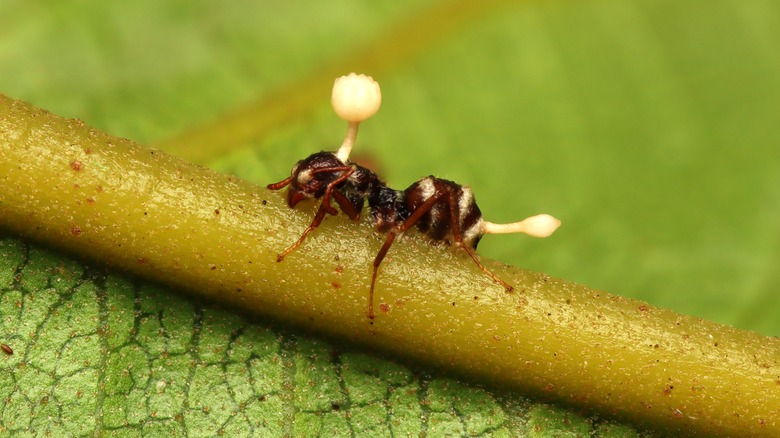Is A Cordyceps Infection Actually Possible In Real Life?
Audiences are still reeling from the roller coaster adventure ride that was season one of HBO's drama series "The Last of Us." However, as we emerge out of a real-life pandemic, the idea of a new breakout infection — even a fictional one — is a little unnerving at best. In light of the show's popularity, experts have weighed in as to whether or not the cordyceps fungal infection responsible for turning the show's characters into zombies is more than just an imaginative storyline.
Scientifically named ophiocordyceps unilateralis, a cordyceps infection is actually possible in real life — but not in humans (via Prevention). Rather, it's ants that are at risk for contracting the dreaded zombie fungus. Once a fungal spore takes hold of the insect and enters the blood, it replicates, overtaking the body and making its way to the brain.
This is the point where the ant begins to display some strange, zombie-esque behavior. The infection prompts the insect to seek higher ground in order to increase sun exposure and create an ideal home for the fungus. As if that wasn't disturbing enough, the fungus will have the ant seek out a specific strategic location, positioning itself on a leaf in close proximity to other nearby, unsuspecting ants.
Cordyceps fungus has limited infection abilities
In the last phase of the infection, the fungal spores flower out of the ant's head (killing the insect, needless to say) and attach to neighboring hosts (per Prevention). Even without direct contact, however, the spores can still be transferred by water or wind.
As previously mentioned, while ants and spiders may be the unfortunate victims to this fungal infection, humans are not. "There are millions of different fungal and mold species out in nature that don't cause any sort of infection in humans, and this is one of them," Dr. Scott Roberts, associate medical director for infection prevention at Yale New Haven Hospital, told the Yale School of Medicine. "A cordyceps that infects one species of ant cannot even infect other species of ants."
Because of these limitations, we can sleep soundly knowing that a widespread real-life cordyceps infection is not likely in the cards for humankind — phew. While certainly reassuring, you may still be wondering as to why small insects are vulnerable to this infection, but not humans. Experts say that the answer lies in body temperature.
Cordyceps fungus can't thrive in the human body
As it turns out, our main line of defense against potential fungal infection is our core body temperature (via Yale School of Medicine). Our internal temperature is just too darn hot. Thankfully, cordyceps fungus is not able to withstand our whopping 98.6-degree Fahrenheit inner environment (approximately 37 degrees Celsius).
The unfortunate news, however, is that some experts believe future cases of zombie-like fungal infections in humans cannot be entirely ruled out. The reason being is that with rising temperatures due to climate change, these fungal species may eventually adapt — but again, this doesn't appear to be a concern for scientists anytime soon. "[M]aybe that will happen in the future, but, at the moment, that is not a possibility," Bryn Dentinger, a biology professor at the University of Utah and curator of mycology at the Natural History Museum of Utah, explained to NPR.
On the opposite side of the coin, some experts believe certain species of cordyceps fungus may actually have health benefits to offer humans. While the research is extremely limited, some studies suggest that cordyceps fungus may aid in fighting off inflammation, cancer, and effects of aging, according to the Cleveland Clinic. It's available as a supplement, though some folks enjoy cooking cordyceps directly into their food. However, consult with your doctor first, as cordyceps may pose risks to people with certain health conditions.



